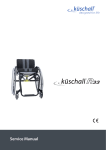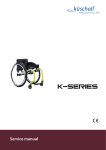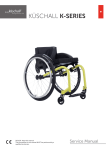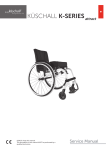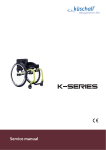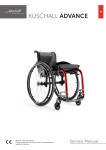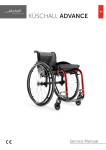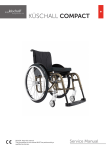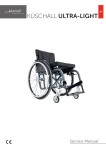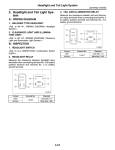Download Service Manual
Transcript
Service Manual Service Manual Inhaltsverzeichnis General.......................................................................................................................... 4 Introduction 4 Spare parts and adaptations 4 Fastening with hexagon socket bolts 4 Torque 5 Checks 5 Identifying and repairing faults 5 Seat................................................................................................................................ 6 Seat width (SB) 6 Seat depth (ST) 6 Rear seat-to-floor height (SHh) 6 Rear seat height adjustment – Low impact system 6 Rear seat height adjustment – without Low impact system 7 Tipping point adjustment 8 Front seat-to-floor height (SHv) 10 Seat angle (SW) 10 Backrest....................................................................................................................... 11 Replacing the backrest tube 12 Backrest angle (RW) 12 Adjusting the backrest height 13 Replacing the handle 14 Replacing foldable push handles 14 Footrests ..................................................................................................................... 15 Lower leg length (UL) 15 Replacing footrests 15 Adjusting the footrest height 15 Fitting and adjusting high-mounted footrest 16 Angle-adjustable footplate, adjusting the angle 16 Side parts.................................................................................................................... 17 Clothes-guard/mudguard 17 Siderests 19 Front wheels................................................................................................................ 20 Replacing a front wheel 20 Replacing a front wheel fork 20 Rear wheels................................................................................................................. 21 Control of rear wheel parallelism 21 Rear wheel axle replacement 22 Brakes.......................................................................................................................... 23 Parking brakes assembly and adjustment 23 Options & accessories................................................................................................ 24 Antitipper assembly and adjustment 24 Fitting the pelvic belt 24 3 © Küschall AG, Schweiz | 2012-11 Service Manual General Introduction This service manual is part of the instructions and contains the technical information for servicing, configuring and repairing a Küschall® wheelchair. WARNING! Danger of accident and severe injuries. If the wheelchair is improperly set it can cause accidents and severe injuries. ▸▸Changes to the wheelchair may only be carried out by the dealer. To guarantee the required safety and reliability, all wheelchairs must be comprehensively checked once a year. In part, assembly and adjustment require extensive experience. For this reason, the following assembly instructions have been split into three categories: Requirement Symbol Easy – technical understanding required Medium – technical knowledge required Difficult – technical knowledge and expertise in assembling wheelchairs required The required tools and their respective sizes are listed above each instruction. The instructions include information on the torques with which the respective screw connections must be tightened. Adhering to the given torques requires the use of a torque spanner. Tool Symbol Allen key à 3, 4, 5, 8 Phillips screwdriver Ò2 Open-end spanner Socket spanner/Box spanner GL SB GB 8, 10, 11, 19 8, 10 Spare parts and adaptations All spare parts may be obtained from the Küschall® customer service department. An electronic spare parts catalogue can be found at www.kueschall.com. Only original spare parts may be used. The written authorisation of Küschall® AG must be obtained before installing additional adaptations on a Küschall® wheelchair. Fastening with hexagon socket bolts Hexagon socket bolts are not designed to withstand an excessive application of force. When tightening or undoing a hexagon socket bolt, force must be applied to the nut wherever possible to avoid damaging the bolt. Tightening and undoing Turn the nut using a socket spanner (only use an open-end spanner if there is insufficient space), using the Allen key simply to stop the bolt turning. 4 © Küschall AG, Schweiz | 2012-11 Service Manual Tightening and undoing when no nut is present If a hexagon socket bolt is screwed directly into a thread, the bolt must be tightened using the Allen key Ensure that the Allen key is of good quality i and not worn. Torque All bolts must be tightened with the torque specified in the following instructions. Checks Visual check Check the entire frame for cracks, especially the areas around joints and welded seams. Checking the screw connections Check all bolts with the torques specified in the instructions regularly, and adjust if required. CAUTION! j Several screw connections have been secured with safety seals. If these are opened, they must be secured again using new safety seals. High-power and low power adhesives are available. For torque entries notice shall be made whether an adhesive and which adhesive needs to be used. Identifying and repairing faults Fault The wheelchair does not travel in a straight line The wheelchair tips too easily The brakes are gripping poorly or asymmetrically Possible cause Action Incorrect tyre pressure on one rear wheel Correct tyre pressure One or more spokes broken Replace broken spoke(s) Spokes tightened unevenly Front wheel bearings are dirty or damaged Backrest angle too large Wrong seat position Incorrect tyre pressure in one or both rear tyres Brake setting incorrect Tighten loose spokes Tyre pressure in rear tyres is too low Correct tyre pressure Rear wheels are not parallel The rolling resistance is very Front wheel axles are restrained by dirt high or hair Bearings are dirty or faulty Too little tension on the clevis pin The front wheels wobble housing when moving fast Front wheel is worn flat The front wheel is stiff or stuck Bearings are dirty or faulty Clean or replace the bearings Reduce backrest angle Change seat position Correct tyre pressure Correct brake setting Make rear wheels parallel Clean front wheel axles Replace the bearings Tighten the nut on the castor fork slightly Replace front wheel Replace the bearings 5 © Küschall AG, Schweiz | 2012-11 Service Manual Seat Seat Seat width (SB) Available seat widths: SB 340 to SB 440, in 20 mm steps. Once it has been set the seat width cannot be modified easily. It requires replacing the seat module, possibly the centerpart, the backrest, axle and possibly the footrest. This modification is not described in the service manual. Seat depth (ST) Available seat depths: ST 375 to ST 475 in 25 mm steps. Adjusting the seat depth requires replacing the entire seat module including seat upholstery and rail, as well as the seat cushion. Rear seat-to-floor height (SHh) Available rear seat heights: SHh 400 to SHh 490 in 10 mm steps. To adjust the rear seat height it is necessary to change the rear suspension configuration of the spring (or fixed connection piece) and distance rings, Chap. Seat; ‹Rear seat height adjustment with/without „Low-Impact-System“›. The following configurations are possible: Rear seat-to-floor height by rear wheel size SHh with ‹low impact system› 24‘‘ wheel 25‘‘ wheel without ‹low impact system› 24‘‘ wheel 25‘‘ wheel 400 — — S1 — 410 — — S2 S1 420 — — S3 / M1 S2 430 1 — M2 S3 / M1 440 2 1 M3 / L1 M2 450 3 2 L2 M3 / L1 460 4 3 L3 / XL1 L2 470 5 4 XL2 L3 / XL1 480 — 5 XL3 XL2 490 — — — XL3 Rear seat height adjustment – Low impact system 3 1 3 7 4 1 5 6 à 7 Nm 7 2 2 6 © Küschall AG, Schweiz | 2012-11 Service Manual Seat Tool: Ã5, 8 Difficulty: Loosen the bolts and remove bolt . Lift up the seat module and remove the spring , elastomer and distance rings (if fitted). Insert spring , elastomer and distance rings according to the required rear seat height, Table ‹Rear seat-to-floor height by rear wheel size (SHh)›. Turn the clamp on the seat module against the spring unit, until all parts fit together. Fasten the spring unit with the bolt (with adhesive). Make certain to use the correct bolt length, Table ‹Rear seat-to-floor height by rear wheel size (SHh)›. Tighten the bolts . Rear seat height adjustment – without Low impact system 4 1 4 1 5 7 à 7 Nm 6 7 3 3 2 2 Tool: Ã5, 8 Difficulty: Loosen the bolts and remove bolt and rings (if fitted). Lift up the seat module and remove the seat-to-frame connection and the distance rings (if fitted). Insert seat-to-frame connection , with or without the distance rings , according to the requested rear seat height, Table ‹Rear seat-to-floor height by rear wheel size (SHh)›. Turn the clamp on the seat module against the seat-to-frame connection, until all parts fit together. Fasten the seat-to-frame connection with the bolt (with adhesive). Slide 1 or 2 rings onto the bolt if necessary, Table ‹Rear seat-to-floor height by rear wheel size (SHh)›. Tighten the bolts . 7 © Küschall AG, Schweiz | 2012-11 Service Manual Seat Tipping point adjustment The tipping point of the wheelchair can be adjusted by changing the horizontal position of the seat module. à 7 Nm 1 à 7 Nm 3 à 7 Nm 2 à 13 Nm 6 4 5 7 Making it easier to tip the wheelchair Tool: à 4, 5 Difficulty: Loosen bolts . Remove bolts (=4 bolts that connect the rear brace and the seat module ). Move the rear brace forward and use the bolts to secure it in the required position. Remove bolts (=4 bolts that connect the front brace and the seat module ). Move the front brace forward and use the bolts to secure it in the required position. Retighten the bolts . Making it more difficult to tip the wheelchair Tool: à 4, 5 Difficulty: Loosen bolts . Remove bolts (=4 bolts that connect the front brace and the seat module ). Move the front brace backwards and use the bolts to secure it in the required position. Remove bolts (=4 bolts that connect the rear brace and the seat module ). Move the rear brace backwards and use the bolts to secure it in the required position. Retighten the bolts . Additional positions can be set by turning the front brace . In this case, i the fastening elements must be moved. When tightening the fastening elements , it must be ensured that the j slots in the fastening elements are parallel to one another and that the distance of both fastening elements from the centre part is identical. 8 © Küschall AG, Schweiz | 2012-11 Service Manual Seat Seat position and tipping point Dimension x Front brace Rear brace Bracket distance Brace distance (1=rearmost, 6=frontmost seat position) (the larger the value of x, the easier it is to tip the wheelchair) (1=frontmost, 4=rearmost position of brace at seat module) (1=frontmost, 5=rearmost position of brace at seat module) (=distance between brackets of front brace) (=distance between rear brace and front brace) 1 154 1 1 small 190 2 131 2 2 small 190 3 108 3 3 small 190 4 85 4 4 small 190 3 108 1 3 large 236 4 85 2 4 large 236 5 62 3 5 large 236 6 39 4 5 large 213 Seat position 54 32 1 4 9 3 2 1 © Küschall AG, Schweiz | 2012-11 Service Manual Seat Front seat-to-floor height (SHv) The front seat height is variable between SHv 460 and SHv 510 (± 10 mm). The front seat height is dependent on several factors that interact with each other. In addition to the size of the rear wheels, the frame, seat depth and rear seat height influence the seat height. The following combinations of front and rear wheels are possible: 75° 90° B C 3'' 4'' 5'' D E F 25 24 A Front and rear wheel combination Rear wheel 24’’ 25’’ Front wheel Frame 3'' 4'' 5'' 75° D C B 90° B A — 75° E D C 90° C B — Only choose wheel and axle combinations specified in the table to i ensure that the frame is straight and the axis of the front wheel fork is perpendicular to the ground. To achieve the desired front seat height, there are three frames of different heights available (long, medium, short): Frame SHv 24’’ 25’’ long 500 510 medium 480 490 short 460 470 Seat angle (SW) The seat angle is determined by the difference between the rear seat height (SHh) and the front seat height (SHv). 10 © Küschall AG, Schweiz | 2012-11 Service Manual Backrest Backrest The adjustable back is fitted with velcro bands and a cover. Apart from the adjustable back there is the light cover, which is produced individually for each backrest height (RH) and seat width (SB). Backrest height (RH) to cover, backrest tube, pushhandles and bands cover backrest tube 270 S pushhandle telescopic tube straight bands above stabilizing bar S S 1-band 285 S S S 1-band 300 S S S 1-band 315 S L S 1-band 330 S L S 2-bands 345 M L S 2-bands 360 M L S 2-bands 375 M L S 2-bands+1-band 390 M L L 2-bands+1-band 405 M L L 2-bands+1-band 420 L L L 2-bands+1-band 435 L L L 4-bands 450 L L L 4-bands 465 L L L 4-bands top band 10 cm backrestband, 2 parts RH standard pushhandles foldable pushhandles 3 2 1 5 7 8 Backrest height (RH) to pushhandles, telescopic tubes and bands 9 without pushhandles RH bands above stabilizing bar 270 1-band S 285 1-band S 300 1-band S 315 1-band S 330 2-bands S 345 2-bands 360 2-bands 375 2-bands+1-band 390 2-bands+1-band 405 2-bands+1-band 420 2-bands+1-band M 435 4-bands L 450 4-bands L 465 4-bands L endband, 10 cm top band telescopic tube bended 10 6 8 7 S S M M M A 1-band strap is placed beneath the stabilizing bar if there is a clothesguard, and a 2-bands strap if there is a mudguard. 11 © Küschall AG, Schweiz | 2012-11 Service Manual Backrest Replacing the backrest tube Tools: à 3,4 Difficulty: 8, 10 Remove the backrest padding. Slide the backrest bands upwards or downwards to gain access to the screws . Remove the screws and nuts on both sides. 1 Remove the push handles or the telescopic tubes and remove the upper Velcro® bands. 2 Remove the screws on the backrest joint. Remove the lower Velcro® bands and the sleeve with the adjustment screw from the backrest tube and fit both to the new backrest tube. Fit the backrest tube to the backrest joint with the screws . Here, first fit the lower screw followed by the upper screw. 3 Fit the upper Velcro® bands and the push handles or the telescopic tubes again and fix them with screws and nuts. 4 Carry out the same setting on both sides. à 7 Nm Refit the backrest padding. à 7 Nm à 7 Nm The excentre plates must be adjusted identically on both sides of the wheelchair, ‹Adjusting the backrest angle›. j Check: Check the settings of the adjustment screws on both sides. The screw head must only lightly touch the seat module when the backrest is in the upright position. If necessary, readjust the length by releasing the counter nut and tightening or loosening the adjustment screw. Then retighten the counter nut . 5 6 Incorrectly adjusted adjustment screws result in damage to the j backrest joint’s mechanism, ‹Adjusting the backrest joint›. Backrest angle (RW) The angle of the backrest can be changed by repositioning the excentre plate in the backrest joint plate. The following angles (measured from the seat) can be set: 82° ° 86 86 ° ° 90 90 78 ° 74 ° 82 ° ° 74 12 ° ° 78 ° 82 ° 82 ° 74 82 ° 82 ° 78 ° ° ° 74 82 ° 82 ° 78 ° 78 ° 74 90° ° ° 90 90 ° ° 86 86 ° 86 ° 90 ° 82 ° 82 86° 82 78° ° 74° © Küschall AG, Schweiz | 2012-11 Service Manual Backrest Adjusting the backrest angle Difficulty: Tools: à 3, 10 1 Fold down the backrest and release the counter nut of the adjustment screw and screw it in completely. Remove the screw on the excentre plate . Remove the excentre 4 plate and reinsert it in the desired position. The excentre plates must be set identically on both sides of the j wheelchair. 5 1 2 Reinsert the screw and tighten it. Fold the backrest up until the stop bolts engage and unscrew the 3 adjustment screw until it touches the frame and the backrest joint no longer moves. 4 Tighten the counter nut . à 4 Nm Adjusting the backrest joint Difficulty: à 7 Nm Tools: 10 Put the backrest up and let the pin engage. 5 Press the backrest forwards to ensure the joint cannot move. 3 3 Unscrew the screw until it touches the spigot of the seat frame. 4 2 Screw the screw back in by between a ¼ and a ½ turn and counter with 1 the counter nut . à 7 Nm Correctly adjust the backrest joint on both sides. Function check: Sit in the wheelchair and lean back so that the backrest is strained. Upon pulling the release cord , the pin must be easily removed on both sides and must fully glide back in upon letting go of the release cord. Adjusting the backrest height Readjusting the push handle/telescopic tube Difficulty: Tools: à 3 8 Remove the backrest padding. Remove the screw connection and adjust the desired height of the push handle or the telescopic tube. Insert the screw connection again and tighten the nut. 1 Carry out the same setting on both sides. Refit the backrest padding. If the desired height cannot be achieved, you must use a different i telescopic tube or push handle. à 7 Nm 13 © Küschall AG, Schweiz | 2012-11 Service Manual Backrest Replacing the handle An adhesive (e.g. hair spray) is used in these instructions. When applied to the handle, this substance works as a lubricant and as an adhesive once dry. After drying, the adhesive used must be able to resist a pull-off force j of 750 N. If in doubt, contact Küschall® AG. Difficulty: 0 Remove the old handle. 0 Remove any residue (residual adhesive, grease, dust) from the push handle tube. 0 Apply a thin layer of hair spray all over the surface of the push handle tube onto which the handle is to be slid. 0 Apply a thin layer of hair spray to the inside of the handle. 0 Slide the new handle onto the push handle tube. 0 Move the handle into the correct position (grooves facing upwards). If a long handle has been fitted and this is to be replaced with a short i one, the push handle tube must be shortened by 35 mm. The push handle tube must be replaced when switching from a short to a long handle. Replacing foldable push handles Difficulty: Tools: Ã4 0 Remove the old foldable push handle and the old threaded sleeve. 3 1 0 Slide the new threaded sleeve onto the telescopic tube . For safety reasons, it is important that a new threaded sleeve is used and that the old sleeve is not left in, and reused for, the telescopic tube. j 0 Slide the new foldable push handle onto the telescopic tube . 4 à 7 Nm 2 0 Fix the foldable push handle with the screw . The telescopic tube must be replaced if a foldable push handle has i not been fitted and a foldable push handle is to be newly fitted. 14 © Küschall AG, Schweiz | 2012-11 Service Manual Footrests Footrests The footrest must be selected in accordance with the seat width. A standard footrest and an angle-adjustable footrest are available. Furthermore, there is the possibility of a high-mounted footrest. Lower leg length (UL) To change the lower leg length, the footrest can be fixed at a higher or lower position. Table, Chap. Frame. The shortest lower leg lengths can be achieved using the high-mounted footrest. ‹Fitting and adjusting highmounted footrest› 1 Replacing footrests Difficulty: Tools: à 4 8 Remove the screw connections on both sides. Remove the footrest and replace it with a new one. Tighten the screw connections on both sides. Carry out the same setting on both sides. à 4 Nm Adjusting the footrest height Difficulty: Tools: à 4 8 The height of the footrest can be adjusted in 10 mm steps. 1 Remove the screw connections on both sides. à 4 Nm Slide the footplate to the desired height. Tighten the screw connections on both sides. Carry out the same setting on both sides. If the desired lower leg length cannot be achieved, a high-mounted i footrest must be used ‹Fitting and adjusting a high-mounted footrest› 15 © Küschall AG, Schweiz | 2012-11 Service Manual Footrests Fitting and adjusting high-mounted footrest Difficulty: Tools: à 4, 5 3 8, 10 Fit the frame bar for the high-mounted footrest to the front frame on both sides using the screw connections . 2 1 Fix the clamp set to both sides of the frame using the screw à 7Nm connection . Only tighten lightly. à 7 Nm 4 Slide the high-mounted footplate into the clamp set and to the desired height. 5 Tighten the screw connections on both sides. Angle-adjustable footplate, adjusting the angle Difficulty: Tools: à 4 10 To adjust the angle, release the four screw connections until the footplate can be moved. Check and/or adjust the distance between the left and the right sides by pushing in or pulling out the tubes below the footplate in such a way that the bearings blocks are perpendicular to the ground. Tilt the footplate into the desired position and tighten the screw 1 connections . The angle of the footplate must be set so that the user’s feet cannot j slide off the plate. 1 à 13 Nm 16 © Küschall AG, Schweiz | 2012-11 Service Manual Side parts Side parts Clothes-guard/mudguard The clothes-guard fitted as standard can be replaced by a mudguard. Clothes-guard and mudguard are available in plastic or in carbon. For the carbon mudguard there is an additional size (XL) for the two smallest rear seat hights (SHh). Clothes-guard size Wheel size SHh 24‘‘ 25‘‘ 400 L L 410 L L 420 L L 430 L L 440 M L 450 M L 460 M L 470 M M 480 M M 490 M M M L Mudguard size plastic Wheel size SHh 24‘‘ 25‘‘ 400 L L 410 M L 420 M L 430 M L 440 M M 450 M M 460 M M 470 M M 480 M M 490 M M L Mudguard size carbon Wheel size SHh 24‘‘ 25‘‘ 400 L L / XL 410 L L 420 L L 430 L L 440 M L 450 M L 460 M L 470 M M 480 M M 490 M M XL L 17 © Küschall AG, Schweiz | 2012-11 Service Manual Side parts Replacing the clothes-guard The mounting element on the backrest must already be fitted. Tools: à 3, 4 Difficulty: If present, remove the clothes-guard to be replaced by loosening the screw connection . 1 3 Check the correct position of the clothes-guard with fitted rear wheel. Here, find the suitable height on the clothes-guard for fixing the screw connection to the backrest mount . If necessary, the holder on the seat module can be replaced. Here, remove the screw . The clothes-guard is correctly positioned if it can be inserted between i the seat module and the holder and the upper edge runs above the 2 à 4 Nm à 4 Nm rear wheel. 4 5 Fitting the mudguard Difficulty: Tools: à 3, 4 10 Ò 2 Remove the clothes-guard and the mounting elements on the backrest and the seat. Fit the holder to the seat module using the screw connections and then refit the rear wheel. 2 Slightly loosen the screws on the adjustment plate and slide it along the mudguard carrier until the mudguard is at the right height. The position of the mudguard can also be adjusted: Here, loosen the screw connections and , position the mudguard as required and tighten the screw connections and again. 1 Tighten the screws again. 4 Carry out the same setting on both sides. 3 By tightening or loosening the screws you can adjust how easily the 2 armrest can be pulled out or pushed in. The existing axle may not be sufficiently long for the new i configuration with mudguard. In this case, a longer axle must be fitted. ‹Changing the wheel chamber / fitting and adjusting an axle› The distance between the mudguard and the wheel must be j > 25 mm in loaded condition to prevent fingers from becoming caught between the wheel and the mudguard. à 7 Nm 5 à 4 Nm à 7 Nm à 7 Nm 18 © Küschall AG, Schweiz | 2012-11 Service Manual Side parts Siderests Fitting and adjusting a height-adjustable siderest Difficulty: Tools: à 4, 5 Ò 2 Fit the holder and the bracket to the seat module on both sides. 2 Tighten the screws only lightly. 4 Fit the bar between the two brackets using the screws . Tighten the screws . To adjust the armrest height, insert the armrest into the holder . 3 1 5 2 Loosen the screws for the height adjustment and slide it into the desired position. 6 Then retighten the screws for the height adjustment. By tightening or loosening the screws , you can adjust how easily the armrest can be pulled out or pushed in. à 7 Nm à 7 Nm 7 à 4 Nm 8 1 19 © Küschall AG, Schweiz | 2012-11 Service Manual Front wheels Front wheels Replacing a front wheel Tools: à 2x3 Difficulty: Remove the screw with disk on one side. Remove the wheel axle . Remove the front wheel . Place the sleeves between the new front wheel and the fork. 2 1 4 Slide the axle through the fork, sleeves and the front wheel and 3 fix the axle using the screw . Here, use the new screw supplied with the wheel as this screw comes with a thread-locking device. 4 1 Function check: à 4 Nm The wheel may not wobble, but must rotate easily. Replacing a front wheel fork Difficulty: Tools: 1 2 5 10 4 Remove the sealing cap of the bearings block by inserting two screwdrivers into the grooves and flipping it off. Remove the nut with the washer . 4 Remove the front wheel fork . 3 Check the ball bearings and replace them if necessary. Insert the new front wheel fork with the washer and the nut and tighten the nut. Carry out the function check (see below). Replace the sealing cap . A Function check: Tip the wheelchair backwards by 90° so that it is lying on the backrest and the rear wheels. Turn the fork upwards (position A) and let it tip downwards. The fork has been correctly adjusted if it easily turns to beyond the bottommost point and remains there (position B). B C If the fork turns back to the lower position (position C), it has not been sufficiently tightened. There is a risk that the front wheels will start to wobble at high speeds. 20 © Küschall AG, Schweiz | 2012-11 Service Manual Rear wheels Rear wheels Control of rear wheel parallelism 2 Tool: à 5 Difficulty: Loosen the two bolts that clamp the centrepart to the axle . Rotate the axle tube to set the correct position. Tighten the two centrepart bolts , then replace the axle protection rings (if fitted). This adjustment must be carried out on a perfectly horizontal i surface. The track of the rear wheel is correct if (measured at height of hub) the distance between the rear wheels is the same at the front and back (x=y). 3 1 5 4 à 7 Nm 21 © Küschall AG, Schweiz | 2012-11 Service Manual Rear wheels Rear wheel axle replacement A new axle has to be fitted if a different rear wheel camber is required. Tool: à 5 Difficulty: A Remove the antitipper (if fitted), Chap. Options and accessories; ‹Antitipper assembly and adjustment›. Remove the rear wheels and the axle protection rings (if fitted). Remove the two bolts that clamp the centrepart to the axle . Remove the axle by sliding it out of the centrepart . 2 It may be necessary to gently prise the centrepart apart slightly with i a boltdriver to remove or replace the axle without scratching it. This must be done very carefully to prevent cracking the coating of the centrepart. 3 Slide the new axle into the centrepart . The centrepart must be approximately in the middle of the axle. 4 Loosely replace the two bolts , then replace the rear wheels. Check that the axle is exactly in the middle by measuring the distance from the inside of the wheel to the edge of the seat module (distance A). Both sides must have the same measurement. If adjustment is necessary, slide the axle to the appropriate side. 2 1 5 Check that the rear wheel parallelism is correct by referring to control of rear wheel parallelism, Chap. Rear wheels; ‹Control of rear wheel parallelism›. à 7 Nm Tighten the two centrepart bolts . Replace the axle protection rings (if fitted) The bore of the axle protection ring is slightly larger at one end to i make it easier to fit it to the end of the axle. Replace the antitipper (if fitted). 22 © Küschall AG, Schweiz | 2012-11 Service Manual Brakes Brakes Parking brakes assembly and adjustment Tool: à 5 Difficulty: 2 Following each positioning, the rear wheel parking brakes (e.g. when j changing the wheel chamber) must be readjusted. The parking brake function is only guaranteed if the tire has the j corresponding air pressure. 3 Ensure sufficient air is in the tyres. Loosen the hexagon socket bolts holding the brake assembly to the frame clamp . à 13 Nm 1 4 Slide the brake assembly to the required position and tighten the hexagon socket bolts . When the brake is on, the brake shoe must press approx. 4 mm i into the tire. Furthermore, please note that very little force is required for i activating and deactivating the brake. If necessary, a brake lever extension can be fitted. Visual check Check that the parking brake is correctly positioned. The brake is correctly adjusted if the brake shoe does not press more than 4 mm into the tire when the brake is on. Function check Place the loaded wheelchair on a ramp with a 7° slope with the parking brake on. The wheelchair must not move. Carry out this check with the wheelchair both facing down the ramp and facing up the ramp. 23 © Küschall AG, Schweiz | 2012-11 Service Manual Options & accessories Options & accessories Antitipper assembly and adjustment 5 2 Tool: à 5 Difficulty: Remove the existing (short) pivot pin and replace with the longer 1 pivot pin . (Please note that the pivot pin is secured with strong adhesive.) 6 4 Loosely assemble the 2 parts of the clamp onto the axle with the bolts . Slide the clamp as close as possible to the centerpart and onto the 7 pivot pin . 3 The pivot pin must be fully engaged in the clamp to prevent the j antitipper from turning on the axle. Tighten the bolts . Slide the antitipper onto the clamp and secure with the QuickPin . 8 Adjusting the height of the antitipper The height of the antitipper can be adjusted by pressing the spring pin and sliding the inner part of the antitipper to the required position until the spring pin locates in the correct hole. Function check: The distance between the antitipper and the ground must be 40 - 60 mm. It must be easy to fold up the antitipper. Tip the wheelchair backwards using the antitipper until the axle is perpendicular to the antitipper’s point of contact with the ground. In this position, the distance between the rear wheel and the ground must be at least 50 mm. x x 50 mm Fitting the pelvic belt Difficulty: Tools: 10 mm ᆳ 1. Remove cap nut and washer . 2. Attach the steel strap to the backrest joint screw using the supplied new cap nut and washer . ᆱ ᆲ Ensure that the webbing of the pelvic belt is not twisted during j assembly and the locking mechanism shows towards the front ᆰ à 7 Nm 24 © Küschall AG, Schweiz | 2012-11 Küschall AG Benkenstrasse 260 CH-4108 Witterswil [email protected] www.kueschall.com Service Manual R33 ENGLISH | 2012-11 küschall® distributors Belgium & Luxemburg: Invacare nv • Autobaan 22 • B-8210 Loppem Tel: (32) (0)50 83 10 10 • Fax: (32) (0)50 83 10 11 • [email protected] Danmark: Invacare A/S • Sdr. Ringvej 37 • DK-2605 Brøndby Tel: (45) (0)36 90 00 00 • Fax: (45) (0)36 90 00 01 • [email protected] Deutschland: Invacare GmbH • Alemannenstraße 10 • D-88316 Isny Tel: (49) (0)75 62 7 00 0 • Fax: (49) (0)75 62 7 00 66 • [email protected] Deutschland: Ulrich Alber GmbH • Vor dem Weissen Stein 21 • D-72461 Albstadt-Tailfingen Tel: (49) (0)74 32 2006 0 • Fax: (49) (0) 74 32 2006 299 • [email protected] European Distributor Organisation: Invacare • Kleiststraße 49 • D-32457 Porta Westfalica Tel: (49) (0)57 31 754 540 • Fax: (49) (0)57 31 754 541 • [email protected] España: Invacare SA • c/Areny s/n • Polígon Industrial de Celrà • E-17460 Celrà (Girona) Tel: (34) (0)972 49 32 00 • Fax: (34) (0)972 49 32 20 • [email protected] France: Invacare Poirier SAS • Route de St Roch • F-37230 Fondettes Tel: (33) (0)2 47 62 64 66 • Fax: (33) (0)2 47 42 12 24 • [email protected] Ireland: Invacare Ireland Ltd • Unit 5 Seatown Business Campus • Seatown Road • Swords • County Dublin – Ireland Tel : (353) 1 810 7084 • Fax: (353) 1 810 7085 • [email protected] Italia: Invacare Mecc San s.r.l. • Via dei Pini 62 • I-36016 Thiene (VI) Tel: (39) 0445 38 00 59 • Fax: (39) 0445 38 00 34 • [email protected] Nederland: Invacare BV • Celsiusstraat 46 • NL-6716 BZ Ede Tel: (31) (0)318 695 757 • Fax: (31) (0)318 695 758 • [email protected] • [email protected] Norge: Invacare AS • Grensesvingen 9 • Postboks 6230 • Etterstad • N-0603 Oslo Tel: (47) (0)22 57 95 00 • Fax: (47) (0)22 57 95 01 • [email protected] • [email protected] Österreich: Invacare Austria GmbH • Herzog Odilostrasse 101 • A-5310 Mondsee Tel.: (43) 6232 5535 0 • Fax.: (43) 6232 5535 4 • [email protected] Portugal: Invacare Lda • Rua Estrada Velha • 949 • P-4465-784 Leça do Balio Tel: (351) (0)225 1059 46/47 • Fax: (351) (0)225 1057 39 • [email protected] Sverige & Suomi: Invacare AB • Fagerstagatan 9 • S-163 91 Spånga Tel: (46) (0)8 761 70 90 • Fax: (46) (0)8 761 81 08 • [email protected] • [email protected] Switzerland: Invacare AG • Benkenstrasse 260 • CH-4108 Witterswil Tel.: (41) (0)61 487 70 80 • Fax.: (41) (0)61 487 70 81 • [email protected] United Kingdom: Invacare Limited • Pencoed Technology Park, Pencoed, Bridgend CF35 5AQ • Switchboard Tel: (44) (0)1656 776 200, Fax: (44) (0)1656 776 201 • Customer services Tel: (44) (0) 1656 776 222 • Fax: (44) (0) 1656 776 220 © Küschall AG, Schweiz | 2012-11


























